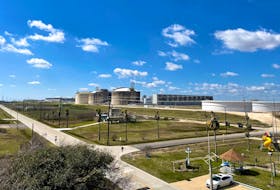Since the announcement of the Lower Churchill hydro mega-project, little has been said of potential developments for other forms of renewable energy.
On Jan. 7, a company proposing a wind farm project for Argentia was kept from proceeding through the environmental assessment process because it did not have an agreement in place for the sale of the farm’s energy (a required step).
With news of the setback, The Telegram decided to take a look at wind projects in Newfoundland and Labrador.
In a 2006 news release, “Newfoundland and Labrador continues to grow as an energy warehouse,” then Natural Resources minister (now Premier) Kathy Dunderdale stated the province was “aggressively pursuing its wind power potential.”
“In addition to the wind on the island, we also commenced a monitoring program in Labrador this summer to determine a more accurate estimate of wind potential in that region. Conservative estimates would suggest that we have in the area of 5,000 megawatts of wind energy capacity in Labrador, so we will certainly be working diligently to strategically develop that clean, renewable energy source in the future.”
When contacted on the subject this week, the response from the Department of Natural Resources was this: Lower Churchill is the priority.
“The government of Newfoundland and Labrador has recently announced the development of Muskrat Falls as part of the Lower Churchill Project. We believe that this development is the most appropriate project to meet the energy needs of Newfoundland and Labrador, and any wind development projects must take place in the context of the Lower Churchill Project,” stated an email from the department.
The response went on to highlight existing wind farm projects in Fermeuse and St. Lawrence and pegged the province’s wind energy potential at an estimated 5,000 megawatts.
Wind power across Canada
The generating capacity of all installed wind power projects in Canada today is between 3,500 and just over 4,000 megawatts, depending on the source.
In Manitoba, the $345-million, 138-megawatt St. Joseph wind farm has recently started to come online. It is located about 100 kilometres south of Winnipeg and is expected to serve 50,000 homes.
In Ontario, four of the largest wind farms in the country are in operation and, in late November 2010, wind energy supporters released statements of congratulations when the province announced wind power projects would be part of its 20-year long-term energy plan.
In New Brunswick, TransAlta announced in early December the completion of a $102-million extension of the Kent Hills wind farm. It now has 50 turbines and can produce 150 megawatts — powering 18,000 homes.
In Prince Edward Island, the government has announced plans to have 500 megawatts of wind power projects by 2013.
Wind power in Newfoundland
“We have just over 54 megawatts of installed capacity in Newfoundland (and Labrador). Compared with the rest of the other provinces, I’ll say that the province has a potential for further development,” said Jean Francois Nolet, a representative with the Canadian Wind Energy Association.
The association promotes the development of wind power projects across the country.
However, while encouraging future development, Nolet said the priority for the province right now should be as it is — the completion of the Lower Churchill hydro project.
He said the potential for wind power in Newfoundland and Labrador lies with energy exports, particularly to the United States. For that to happen, infrastructure in Labrador and the island — and connecting the island to the mainland — will be needed.
“Even though you have a very large amount of wind, you have to be able to sell that electricity,” he said, adding hydro power sales from the Lower Churchill should lay the groundwork for the sale of wind power.
“Wind power and hydro are the best couple. They go hand to hand. Wind is the perfect complement to hydro. Wind cannot replace hydro, however,” he said.
At the same time, the value of 5,000 megawatts of potential wind power cannot be ignored.
“Especially Newfoundland and Labrador has a huge, a tremendous, wind resource. And even with obstacles, we believe the potential for wind development in the province is very appealing,” Nolet said.

![['Wind turbines in Ramea are etched against a setting sun. Despite lots of talk about developing wind power in this province, the provincial government has said the Lower Churchill project must be a priority — Telegram file photo']](https://saltwire.imgix.net/ramea-wind-turbines-1325446.jpg?cs=srgb&fit=crop&h=568&w=847&dpr=1&auto=format%2Ccompress%2Cenhance)







